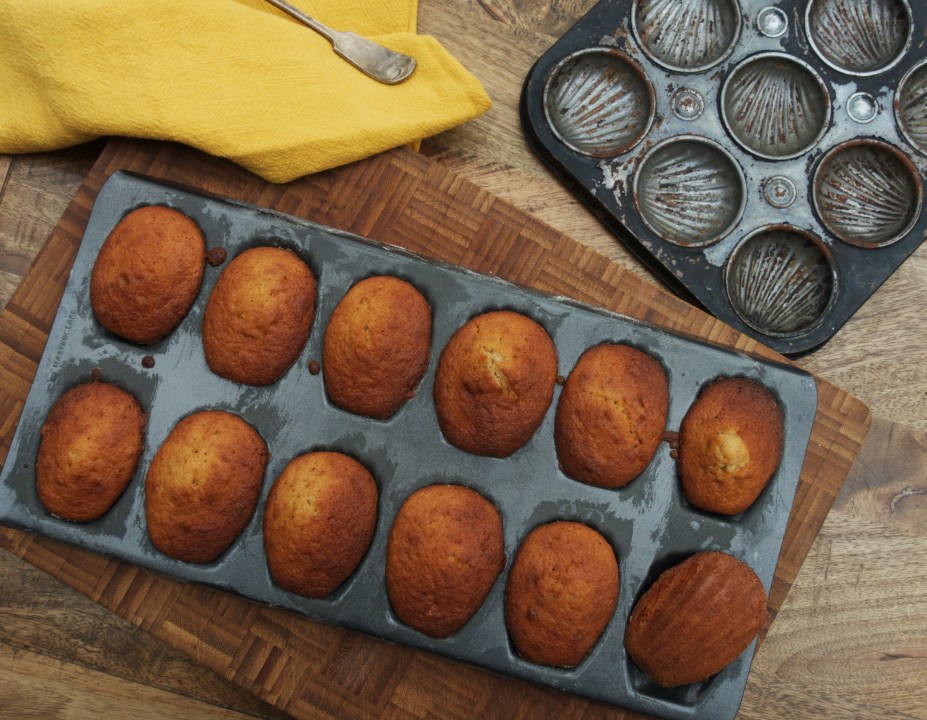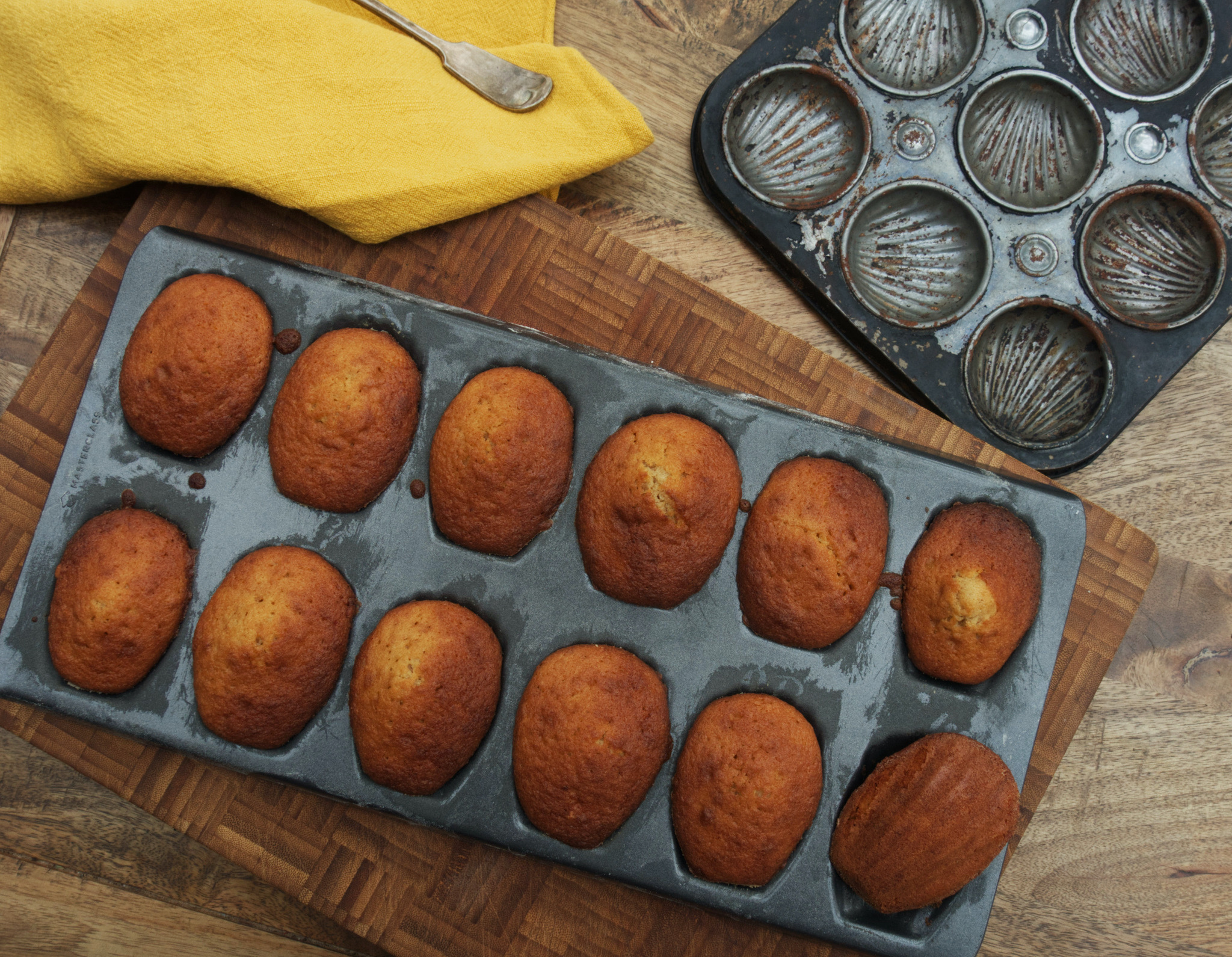In one sense, a madeleine is simply a small cake. In fact, it’s an extremely classic cake, made with the genoise method. But there’s more to a madeleine than that: the proportions of madeleines, their miniature nature and scalloped shape, mean that they have a perfect contrast between their slightly sticky, almost crisp outside, and impossibly light and soft interior. Traditionally they are made with browned butter, which does what browned butter does best, bringing depth and complexity to a straightforward sponge. The dark muscovado and honey in the recipe elevate these little sponges from a miniature cake into something really special.
The holy grail when madeleine making are those characteristic bumps in the centre of the cake, sitting like pregnant tummies. The genoise sponge – where whole eggs are whisked with sugar until super thick, then flour is folded into it, followed by melted butter which is drizzled gently into the batter – helps. This method of incorporation retains as much air in the batter as possible. But really, those bumps are created by the shock of the cold batter hitting a hot oven, which kickstarts the raising agents before the batter has a chance to set. We exaggerate this by letting the batter rest in the fridge for several hours (ideally overnight), and chilling the tin in the freezer, and then preheating the oven super high.
When I was taught to make madeleines at culinary school, the chef taking the lecture told us that he couldn’t tell us the trick to that iconic bump beyond – he dead panned – ‘making them perfectly’. Aside from the fact that that is deeply unhelpful advice, I’m not sure I buy it, to be honest, especially at home in fan-assisted, slightly uneven ovens. To be candid, when I make a batch of madeleines – even when I make them perfectly – perhaps a half or ⅔ will show off a proud little tummy. The rest won’t. And that’s not because they haven’t risen beautifully, or because the moulds have been greased badly. It’s just because there are hot spots and cool spots in my oven, and this tends to be more pronounced when you’re dealing with very high temperatures like we are here.
But, the truth is, even if you don’t end up with a dozen little bumps, the madeleines will still be beautiful and delicious. Similarly, madeleines are traditionally baked in scalloped shaped tins, but if you don’t have a madeleine tin, you can make the cakes in muffin tins, and they will taste just as lovely.
You can glaze or chocolate-dip the baked madeleines, you can add lemon zest or berries or orange blossom water, but for me, there’s no need. A madeleine is at its best unadorned. Using a prominently flavoured honey is great though, as the flavours will really shine in the simple batter – try a dark chestnut honey, something delicate and floral like lavender honey, or a punchy buckwheat honey.
Madeleines are at their best freshly baked – and I mean really freshly baked. Lots of restaurants who make them will have a caveat alongside them on the menu: ‘(20 minutes)’. They know that an oven-fresh madeleine, one knocked out of its mould moments before it arrives in front of you, is, frankly, unbeatable. A still warm, fragrant madeleine is one of the best possible ways to end a meal. But – and if anyone asks if I said this, I will deny it vociferously – there is a small cheat if you find yourself overwhelmed with madeleines, or unable to whip a batch up half an hour before they’re needed. It’s not quite the same, but you can revive them in the microwave. I know! Sacrilege! But 10-15 seconds in a microwave will restore their plump, tender loveliness, and breathe fresh life into them. So if, like me, you fancy making a batch of madeleines for a small household (or just for yourself), then this is a good way of lengthening their life a little. But for the love of God, no one tell the French I said so.
You can glaze or chocolate-dip the baked madeleines, you can add lemon zest or berries or orange blossom water, but for me, there’s no need. A madeleine is at its best unadorned.

Madeleines
Makes: 12 madeleines
Takes: 15 minutes, plus chilling
Bakes 10 minutes
100g butter, browned, plus extra for greasing the tray
¼ teaspoon fine salt
2 tablespoons runny honey
90g plain flour, plus extra for the tray
1 teaspoon baking powder
2 teaspoons dark brown sugar
60g caster sugar
2 large eggs
1. First, lightly brown the butter: melt the butter in a small pan over a medium high heat. It will melt, then boil, then the bubbles will subside, and foam will take its place. As the foam subsides brown specks will appear, and the liquid butter will be golden brown. Remove from the heat, leave to cool for a few minutes, then stir the honey into the butter.
2. Whisk the eggs and both sugars together until very thick and ribbon-like – this can take up to 10 minutes with an electric whisk. Fold in the salt and flour, and then the cooled butter and honey. Decant into a bowl, cover with clingfilm that touches the surface of the mixture. Refrigerate for at least 3 hours and up to 2 days.
3. Generously grease a madeleine tray with butter, getting into all the crevices. Sprinkle with flour, and move and tap the tray so that it completely covers the moulds. Give the tray a really good bang over the bin or sink so that only a thin coating of flour remains. Place the tray in the freezer.
4. When you’re ready to bake, preheat the oven to 230°C. Divide the mixture between the madeleine moulds, filling them about ¾ full – don’t overfill as the madeleines will expand and you’ll lose definition.
5. Place the Madeleine tray in the oven, and immediately turn the heat down to 200°C. Bake for 9-10 minutes until the cakes are golden and taut. Turn out of the moulds and eat immediately.







Comments